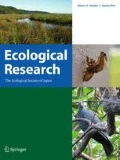We are pleased to present the March issue of Ecological Research as a special issue as a part of the commemoration to mark the 7th East Asian Federation of Ecological Societies (EAFES) International Congress held on 19–22 April 2016 in Daegu, Republic of Korea. The EAFES established in 2003 collaboratively by the ecological societies of China, Japan, and the Republic of Korea aims at promoting ecological science in East Asia by exchanging knowledge and strengthening research capacity via regular symposia, meetings, and joint research and contributing to develop the ecological science and society in East Asian countries, holding a congress every 2 years. The 7th Congress of EAFES, attracting 450 delegates from 12 countries, covered a variety of topics including restoration ecology, climate change, genotype data, plant invasions, polar ecology, rice farming, modeling, nutrient cycle, aquatic systems, animal ecology, forest ecology, and long-term ecological research, etc., and one of them was organized by East Asia Biodiversity Conservation Network (EABCN) entitled ‘Climate change adaptation and plant conservation through vegetation shift monitoring’.
The EABCN, upon the background of globally initiated biodiversity conservation goals and strategies, such as Target 15.3 of Sustainable Development Goal and Global Strategy for Plant Conservation (GSPC) 2020, was established for the regional cooperation on biodiversity conservation in East Asia by six organizations from five countries (China, Republic of Korea, Japan, Russia, Mongolia) in 2014. The EABCN is institutionalized based on a working group (WG) conducting collaborative research and data collection to implement a mid- and long-term regional plant conservation strategy in East Asia. Currently, four WGs under the EABCN are in operation. The WG on Flora of Northeastern Asia (Plant Checklist) targets reviewing plant lists collected and re-arranging the scientific names and synonyms in response to the GSPC target of completing World Flora, with preparation of a web-based platform. It has been completed to combine 130,000 scientific names of plants in the Korean peninsula and three provinces of China (Jilin, Liaoning, Heilongjiang), and it will be completed to combine the scientific names of plants in Mongolia and Far Eastern Russia by the end of 2018. The WG on Plant Phenological Monitoring targets monitoring East Asian common, rare, and local endemic plants interacting through the website of the East Asia Phenological Network. The WG on Joint Publication targets endemic plants in East Asia, which tells the history, botany, ethnic use, cultural relation, etc., for public awareness. The WG on Vegetation Monitoring in response to Climate Change targets intensive and extensive long-term monitoring in a transitional zone to understand the changes in the species composition and habitat by climate change.
The EABCN at its symposium invited leading researchers from China, Republic of Korea, Japan, Russia, and Mongolia and shared research progress and outcomes on the topics of climate change, forest vegetation monitoring, stand dynamics, plant phenological monitoring, and change of biodiversity in shifting vegetation zones, etc. After the symposium, the EAFES Committee and EABCN Secretariat decided to publish a specially edited issue of Ecological Research to mark this occasion. This special issue is designed not only to feature the talks during the symposium but also to present inter-disciplinary research on plant ecology under the climate change impact, which covers the topics of soil flux, tree physiology, distribution modeling, carbon sequestration, landscape change, vegetation phenology, etc., as well. The special issue consists of 12 papers contributed by the EABCN members and specially invited professionals will give readers an idea of how different scale, from micro- to macro-scale, of research on climate change impact and its detection can contribute to describing the bigger picture in climate change and plant ecology research areas. In addition, this special issue is expected to contribute to draw the measures in response to climate change, as well as make mid- and long-term scenarios for climate change adaptation at the regional level, which the IPCC 5th Assessment Report has emphasized to go forth. We hope the EABCN will be expanded to Central, Southeast, and South Asia for developing into Asia Biodiversity Conservation Network (ABCN) so that more effective regional research can be conducted in the future.
For this 7th EAFES memorial special issue, the papers were called under the keywords of East Asia, climate change, and/or biodiversity. Finally, 12 papers are published here.
Last but not least, we would like to thank all who kindly contributed their papers for this issue and the editors of Ecological Research as well as Dr. Takayuki Kawahara (Director General of Hokkaido Research Center, Forestry and Forest Products Research Institute) and Dr. Ho Sang Kang (Research Professor, Seoul National University) and Dr. Shin-ichi Nakano (Professor, Kyoto University) for their kind help and cooperation.
Author information
Authors and Affiliations
Corresponding author
About this article
Cite this article
Lee, C.S., Lee, Y.M. Preface to the special issue. Ecol Res 33, 287–288 (2018). https://doi.org/10.1007/s11284-018-1586-0
Published:
Issue Date:
DOI: https://doi.org/10.1007/s11284-018-1586-0

